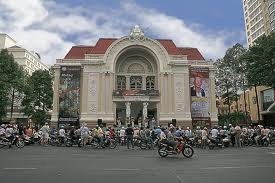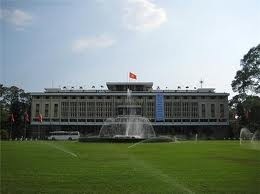Situated at 339 Nam Ky Khoi Nghia Street, District 3 (just near Cong Ly Bridge), this biggest Mahāyāna Buddhist pagoda in Ho Chi Minh City, is rather a young pagoda. In 1964, when monks Thich Tam Giac and Thich Thanh Kiem from the North came there to spread Buddhism, Vinh Nghiem Pagoda was started constructing following the design of the architect Nguyen Ba Lang, based on the model and namesake of the 11th century Vinh Nghiem Pagoda in Bac Giang Province. It was completed in 1971. A Devotee Relic four-storey Tower (Bao thap Xa loi Cong dong) with 25m high was erected behind the pagoda in 1982.
Located right in the heart of Ho Chi Minh City - at number 2, Paris Commune Street, District 1, The Central Post Office is one of the oldest buildings in Ho Chi Minh City. It was built around 1886 – 1891, based on the design of Gustave Eiffel – a famous French architect and has become a significant symbol of the city, just like its opposite neighbor Saigon Notre-Dame Cathedral. It has long been the busiest post office of the country.
BEN THANH MARKET
Believe it or not, even though you have spent years shopping at several malls and commercial centers that shopping has become a boring and ordinary task to you, exploring an Asian market is always an exhilarating experience. VisitBen Thanh Market in Ho Chi Minh City, Vietnam and you will understand. Being a bustling market in the daytime and a social center after sunset, Ben Thanh Market is absolutely a must-see attraction of the most dynamic city of Vietnam.
SAIGON OPERA HOUSE

If you have a chance to go to Ho Chi Minh City, you certainly can’t take your eyes off the elegant architecture of the Saigon Opera House.
Located at the start of the famous Le Loi Avenue, the building still retails many lively evidences for the influence of French architecture in Vietnam.
At the turn of the 20th century, this magnificent building, designed by French architect Ferret Eugene, was built as a classical opera house with 800 seats to entertain French colonists. Anyone who has been to France can recognize many similarities between the Opera House and the Petit Palais. In fact, just like the Reunification Palace, the applied ornament, balustrades, cartouches, and roof were imported directly from France. After 1956, the house functioned as home of the Lower House Assembly of Southern Vietnam. It’s not until 1975 that the opera house was restored to its original purpose of use. Today, the theatre stands at the start of the famous Le Loi Avenue, just adjacent to Hotel Continental and Caravelle, right in the heart of the city.
SAIGON NOTRE-DAME CATHEDRAL

Ask any local people about the location of the city’s center or its symbol, the answer would definitely be Ben Thanh Market or Saigon Notre Dame Cathedral (officially Basilica of Our Lady of The Immaculate Conception). While the market stands at a modern and crowded corner of the business district, the ancient cathedral is located in a very peaceful picturesque corner in the downtown of Ho Chi Minh City.
Constructed between 1863 and 1880 by the French colonists, following their conquest of the city, the building reaches a height of up to 60m. Bishop Lefevre put the first stone for construction of the church on 28 March 1863. Initially, it was called Saigon Church. The name Notre-Dame Cathedral was given after Bishop Pham Van Thien held a ceremony to install the statue of Peaceful Notre Dame, made with granite from Rome, in 1959. In 1962, Vatican anointed it as Saigon Chief Cathedral conferred it basilique. Since this time, this cathedral is called Saigon Notre-Dame Cathedral Basilica.
The cathedral’s address is No. 1 Cong truong Cong xa Paris St., right at the intersection of Pham Ngoc Thach St, Le Duan St and Cong xa Paris St.
REUNIFICATION PALACE, HO CHI MINH CITY

Like Long Bien Bridge in Hanoi, Reunification Palace (formerly known as Independence Palace) has stayed in the mind of many generations of not only Vietnamese but also foreigners. It is known as the famous historical witness which passed through the two fierce wars against the French and American colonists. The palace was built on the site of the former Norodom Palace, a landmark in Ho Chi Minh City and designed by architect Ngo Viet Thu. As Vietnam was split into North Vietnam and South Vietnam, the building served as presidential home and workplace. Today in most locals' minds, the palace is remembered vividly as a marked end to the war, just like the fall of Berlin Wall, as the North Vietnamese tank crashed its gates on April 30th, 1975.
Its current address is at 135 Nam Ky Khoi Nghia Street, District 1, Ho Chi Minh City - right at one end of Le Duan Street. It borders other 3 streets: Huyen Tran Cong Chua Street in the back, Nguyen Thi Minh Khai Street on the right and Nguyen Du on the left.